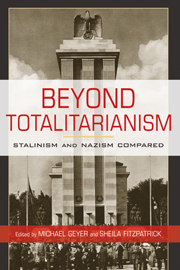Book contents
- Frontmatter
- Contents
- List of Contributors
- Acknowledgments
- Beyond Totalitarianism
- 1 Introduction
- PART I GOVERNANCE
- PART II VIOLENCE
- PART III SOCIALIZATION
- 6 Frameworks for Social Engineering
- 7 Energizing the Everyday
- 8 The New Man in Stalinist Russia and Nazi Germany
- PART IV ENTANGLEMENTS
- Works Cited
- Index
- References
7 - Energizing the Everyday
On the Breaking and Making of Social Bonds in Nazism and Stalinism
Published online by Cambridge University Press: 05 June 2012
- Frontmatter
- Contents
- List of Contributors
- Acknowledgments
- Beyond Totalitarianism
- 1 Introduction
- PART I GOVERNANCE
- PART II VIOLENCE
- PART III SOCIALIZATION
- 6 Frameworks for Social Engineering
- 7 Energizing the Everyday
- 8 The New Man in Stalinist Russia and Nazi Germany
- PART IV ENTANGLEMENTS
- Works Cited
- Index
- References
Summary
Hannah Arendt's suggestion that social “atomization” was fundamental to totalitarian domination has appealed greatly to many scholars and intellectuals. Despite, or perhaps because of, this, it is a hypothesis whose empirical fit with the societies it purports to describe has never been seriously scrutinized. We took it as starting point for our comparative inquiry into the everyday in Nazi Germany and Stalinist Russia that in each case some kind of breakdown (but perhaps also a reconfiguration?) of social relationships took place.
Arendt's analysis focuses not only on the apparatus of domination and its manipulative and represses tactics. In her view more fundamental is the “movement” of “masses of lonely men” looking for shelter from a world they encountered as “wilderness.” Thus, Arendt finds that the appeal of totalitarian movements and regimes is not fabricated from “above.” Rather, she contends, the rulers “rely on that compulsion with which we can compel ourselves.” Recent research has shown that it is this urge which drives people to participate actively in the “great cause” of the respective regimes. It is here that the “inner face” of the many who accepted, if not supported, them comes into view. In our view it is central for understanding the productive and even more the destructive potential of these regimes to address the emotional charges that drove their respective dynamics “from within”: what were the practices of (self-)energizing which people employed or encountered?
The perspective Arendt pursues needs debate in another regard.
- Type
- Chapter
- Information
- Beyond TotalitarianismStalinism and Nazism Compared, pp. 266 - 301Publisher: Cambridge University PressPrint publication year: 2008
References
- 3
- Cited by



